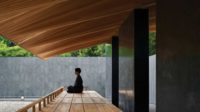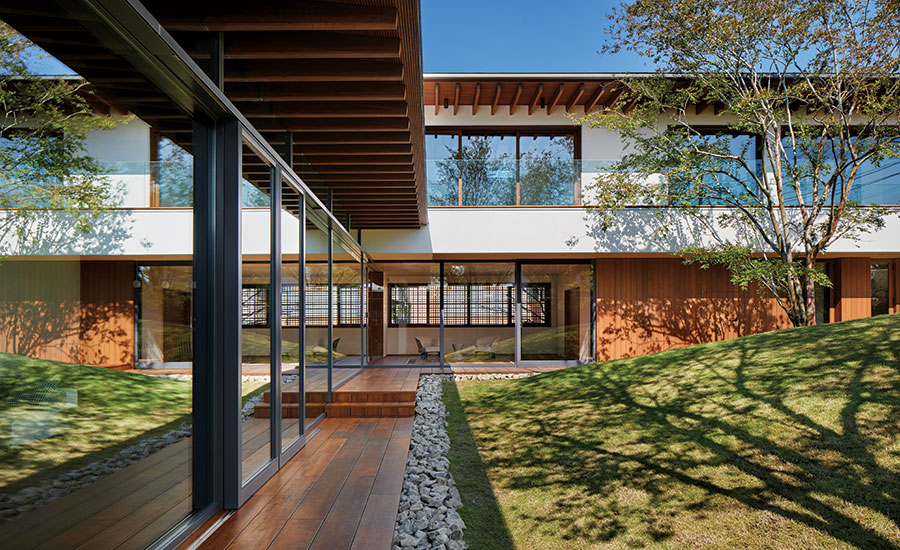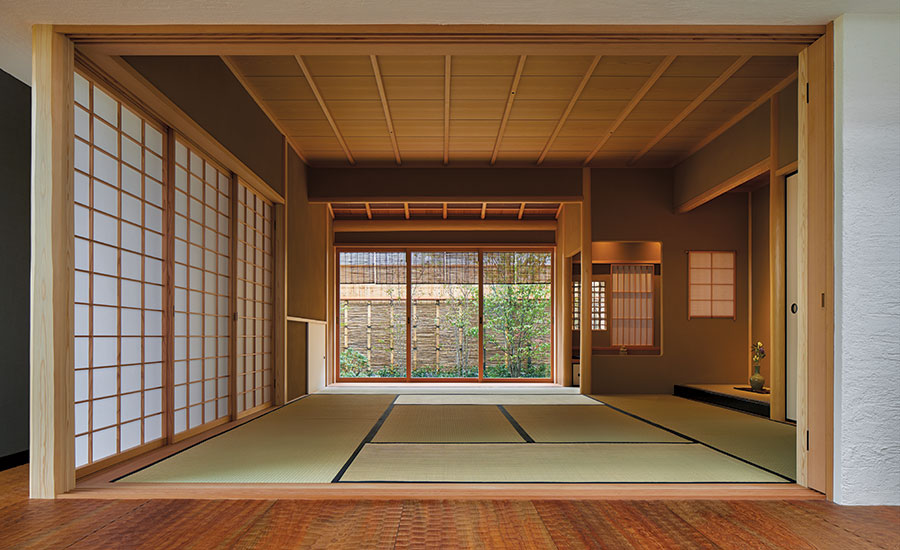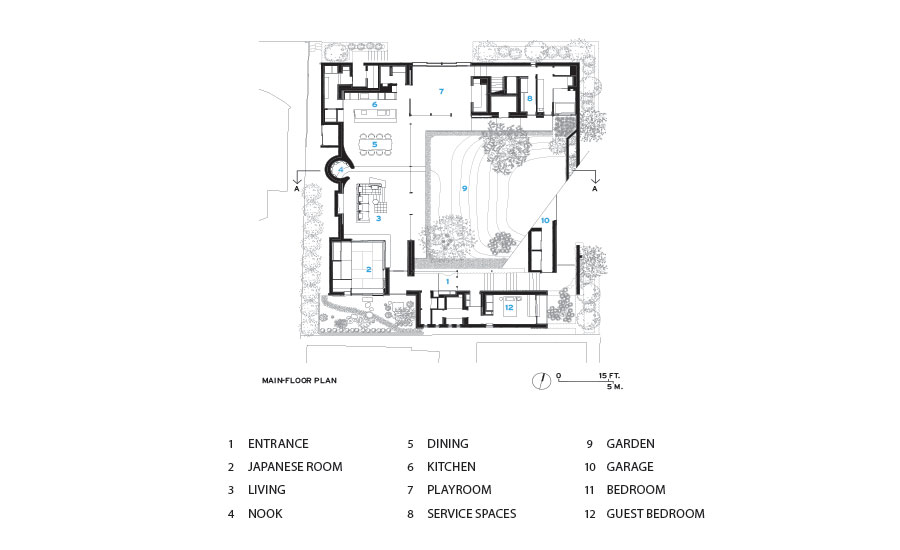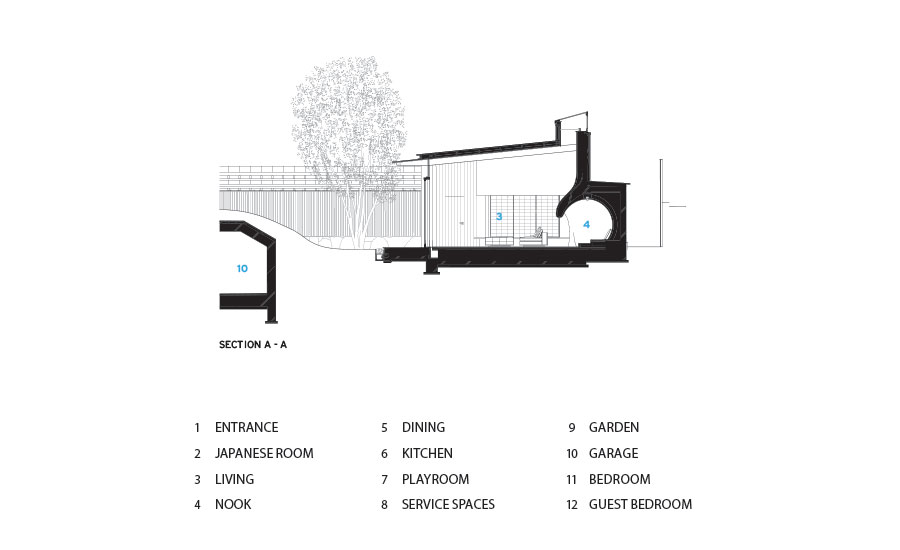Lath House by Hiroshi Nakamura & NAP
Tokyo

Protected by Nakamura’s characteristic deep eaves, engawa-type porches on the ground floor and glass-enclosed balconies upstairs open toward the hilly garden.
Photo © Koji Fuji / Nacasa and Partners

Bands of materials, such as Aji stone, metal lath, and white plaster, emphasize the house’s horizontality and shield the interior from the street.
Photo © Koji Fuji / Nacasa and Partners

Bands of materials, such as Aji stone, metal lath, and white plaster, emphasize the house’s horizontality and shield the interior from the street.
Photo © Koji Fuji / Nacasa and Partners

A point of interest between the living and dining areas, the womb-like nook showcases the plasticity of plaster forming the back wall.
Photo © Koji Fuji / Nacasa and Partners

Glass expanses, topped by clerestory windows along with skylights, fill the dining and living spaces with natural illumination, supplemented by ceramic pendant fixtures over the dining table.
Photo © Koji Fuji / Nacasa and Partners

Glass expanses, topped by clerestory windows along with skylights, fill the dining and living spaces with natural illumination, supplemented by ceramic pendant fixtures over the dining table.
Photo © Koji Fuji / Nacasa and Partners

A large window in the guest bedroom frames a view of the pine tree near the entrance to the house.
Photo © Koji Fuji / Nacasa and Partners

Enclosed with shoji screens, the tatami-mat room looks out at the Japanese-style garden in one direction and the living area in the other.
Photo © Koji Fuji / Nacasa and Partners

Stone steps leading up from the gated entrance merge with the entrance vestibule.
Photo © Koji Fuji / Nacasa and Partners

Stone steps leading up from the gated entrance merge with the entrance vestibule.
Photo © Koji Fuji / Nacasa and Partners

Image courtesy Hiroshi Nakamura & NAP

Image courtesy Hiroshi Nakamura & NAP

Image courtesy Hiroshi Nakamura & NAP













Architects & Firms
Far from the chaos of the city, Hiroshi Nakamura’s Lath House forms a quiet oasis in Tokyo, concealed from the public street in its own private realm. Reminiscent of the traditional Japanese house and garden, its barriers disappear and boundaries dissolve once you are inside. Here the design reveals a luxurious sweep of space that surrounds a courtyard filled with a man-made hill. The mound had to be high enough to accommodate a two-car garage underneath yet low enough not to overwhelm the interior spaces. Borrowing the concept of the traditional tsukiyama, an artificial hill that reflects moonlight, the sloping surface bounces light inside, illuminating the home’s tactile surfaces and rich materials. An unexpected bonus, this landscape offers an informal place for play and relaxation, much like an American backyard.
Additional Content:
Jump to credits & specifications
The merging of architecture and nature has a long history in Japan. For centuries, many of the country’s houses were built according to additive plans whose rectangular rooms literally stepped out into the garden. With those precedents in mind, Nakamura approached his clients’ 9,150-square-foot corner site—a generous parcel, but saddled with building-setback and size and height constraints. Nakamura responded to these conditions with a single-story, C-shaped volume (only the north side holds two floors) surrounding a 2,420-square-foot, square void for the sloping garden in the middle. A gridded fence walls off the fourth side of the garden from the street, although cars can take a ramp beneath it to go down to the garage.
On foot, you enter the compound from the street via a stepped breezeway that leads up to the front door, as well as to the independent guest quarters occupying the building’s south side. Within the main part of the residence, the rooms are arranged in a linear fashion, flowing from one to the next and setting up a spiral path of movement around the garden. “We designed the house as if plotting a story instead of molding a sculptural object,” explains Nakamura. Fittingly, the sequence starts with a multipurpose Japanese-style room whose sliding shoji screens may be pushed aside, merging its tatami-floored space with the adjacent living area. This latter space is surfaced in textured white plaster that morphs into a quirky, cave-like nook intended for relaxation. “It’s kind of an homage to the fireplace in Gunnar Asplund’s own summer house,” says Nakamura. A few additional steps take you to the dining area, followed by the open kitchen and various service spaces. Upstairs are bedrooms, including the master suite.
On both levels, window walls are oriented toward the grassy knoll. “From each room, you get a different perspective on the garden,” says project architect Kohei Omori. Intended to block as little of the view as possible, the hybrid structural system includes timber rafters suspended from concealed roof beams made of wood and steel, slender steel columns ringing the courtyard, and reinforced-concrete walls and foundation.
In contrast to the mounded landscape in the center, Nakamura tucked a smaller, Japanese-style garden off to the side meant mainly for viewing. This careful composition of stone and plant elements was created with the aid of a skilled gardener, while the hill’s shape grew out of the architect’s many model studies.
Throughout the house, teak plays a prominent role, covering the floors, kitchen cabinetry, and the engawa-type ledge wrapping around two sides of the Japanese-style room. Created in consultation with a renowned carpenter, the room quotes from history in its use of wood, paper, and bamboo elements. Natural bamboo surfaces the ceilings of the bedrooms as well—another reference to the past.
Outside, the architect chose an equally expressive palette. From the street, the house reads as a rectangular volume articulated by horizontal bands of different materials. Quarried and cut on the island of Shikoku and then trimmed to fit on-site, rust-tinged Aji stones make a strong statement; these huge rocks, crafted by a stonemason, form the base of the house. A notable feature of the dwelling is the gridded fence above the base, modeled after yoshigaki bamboo lath, which is what spurred the architect to call this Lath House. Originally the substructure of utilitarian rammed-earth walls, these delicate constructions were admired by Japan’s tea masters, who left them exposed as windows in their teahouses. Rendered here in welded aluminum, with a rust-colored powder coating and resin ties, Nakamura’s version bows politely to this legacy.
CreditsArchitect: Hiroshi Nakamura & NAP — Hiroshi Nakamura, managing architect; Kohei Omori, Takeshi Ito, registered architects; Hidenori Sakai
Engineers: Yamada Noriaki Structural Design Office (structural); Akeno Facility Resilience (m/e)
General contractor: Satohide
Consultant: Asahi Building-Wall Co (custom aluminum screen, cutout laminated glass) |
SpecificationsExterior Cladding Granite Stone Walls (Aji Stone): IZUMI STONE WORKS Lath: ASAHI BUILDING-WALL CO., LTD.
Roofing Titanium Zinc Alloy Roof Sheeting: SHINSEISHOJI CO., LTD.
Windows Wood frame: IH WOOD WINDOW Metal frame: OMOKAWAKENKI SEISAKUJO
Glazing Cutout Laminated Glass: ASAHI BUILDING-WALL CO., LTD. Skylights: Nissho GRASYS
Doors Gate: OMOKAWAKENKI SEISAKUJO Steel doors: OMOKAWAKENKI SEISAKUJO Wood doors: IH WOOD WINDOW Garage door: WORLD GARAGE DOOR
Hardware Locksets: MIWA LOCK Security devices: SECOM
Interior Finishes Cabinetwork and custom woodwork: Sakura Corporation Floor and wall tile: Avelco Wood Flooring: BO & CO. Plaster Wall: Ajima Sakan Kougei Ribbed Japanese Larch Ceiling Panel: TAKAGIN WOOD WORKS
Lighting Downlights: DAIKO, MAXRAY, Izumi Okayasu Lighting Design, Exterior: DAIKO, MAXRAY Dimming system or other lighting controls: DAIKO |

